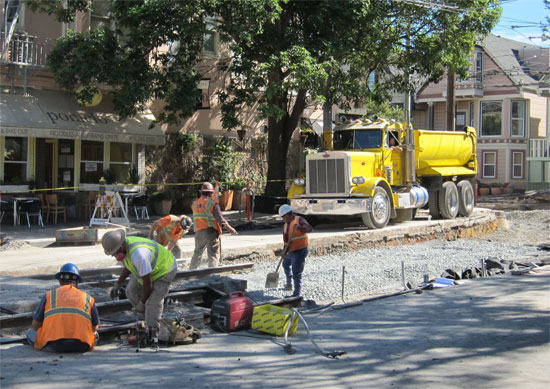
Taking advantage of a long weekend, a capital construction crew of the San Francisco Municipal Transportation Agency (SFMTA), which runs Muni, spent three frenzied days working around the clock to replace aging J-Church tracks at the intersection of Church and 30th streets.
The work on the intersection cost $1 million and was part of the SFMTA’s Rail Renewal Program, a $141 million effort to rehabilitate ten key sections of Muni's more than 70 miles of track much of which is more than 30 years old.
The tracks at the intersection had worn down substantially, leading to increased wear on the trucks and other equipment on the Breda light rail vehicles (LRVs) and noisy conditions with each passing vehicle. The SFMTA hoped that by working 24 hours a day over a holiday weekend, when many people would be out of town or spending the beautiful late summer days at the beach, the clamor of construction wouldn't too greatly inconvenience the neighborhood.
"San Francisco’s infrastructure is at the core of our quality of life," SFMTA boss Nat Ford had said in a statement leading up to the construction. Ford also thanked businesses in the construction zone for their patience and encouraged neighbors to frequent them during the project. "The SFMTA will continue to aggressively prioritize keeping Muni in a state of good repair in order to provide safe and reliable service to our customers."
As a resident living very nearby (30th and Church is my regular J-Church stop), I received one of 8,000 direct mail inserts that were sent out weeks in advance of the project. I knew there would be some traffic and Muni service disruptions, but I had no idea the process of digging up the tracks and replacing them would be so interesting and involved.
As the construction crews started ripping out the old tracks and the aged railroad tie timbers, J-Church service north of Day Street utilized crossover tracks to reverse direction, creating a temporary terminus point between Day and 29th Streets. Though I had carefully crossed those same tracks tens of times on my bicycle when vehicles were double parked in front of Toast Eatery or Henry's Hunan, it never occurred to me that the crossover would be used for such a purpose. At the intersection of Day and Church, parking officers were stationed the entire time, more often than not telling Muni passengers where to pick up the shuttle, only occasionally moving the traffic cones to allow construction vehicles through.

After ripping up the old track and ties, the construction crews brought in trucks of gravel to lay down as the bed on which the new tracks would sit.

They worked through the night from 7 pm Friday until 4 am this morning, creating a ruckus, though some neighbors I talked to acknowledged it wasn't nearly as disruptive as they had expected. One woman said, "I just closed all the windows and wore ear plugs. It wasn't nearly as bad as I thought it would be."


In addition to replacing and repairing aging Muni tracks, the SFMTA added a new signal for Muni operators and pedestrians to benefit alike. Beyond the rail infrastructure, the project included collaboration with other city departments to provide long-overdue enhancements to the surrounding area such as street repaving and re-striping, sidewalk improvements and upgraded water lines.

By Monday morning, the crews had finished laying most of the track, which then had to be tested to guarantee the gauge was precise, no small matter I would learn on a 90 degree turn. I had come down to the construction zone as I did each morning to get a few more pictures, when I realized the crews were already testing the tracks with an actual Breda LRV. One of the job foremen I spoke with explained there was no point in using a lighter dummy vehicle to test the tracks' alignment: it had to work with the real thing, so they tested it that way.
By 11 am, they had already tested the main track to their satisfaction, but they still needed to guarantee the turnaround spur just west of the intersection was adequate. Using an LRV that was staged on the 30th street spur, a Muni operator started into the turn when I heard a loud popping sound and the pantograph attached to the overhead wires came unhooked (great, I thought, this being Muni, of course the pantograph would come undone).
After that gaffe had been resolved, I watched as a very skillful driver inch an 80,000 pound vehicle into the turn, my pulse rising as I began to wonder what surprises were next. For the first few moments, everything seemed to move smoothly with the Breda, before the right front truck popped downward and the operator hit the brakes. The construction crews hustled over to the vehicle with track jacks and levers, while the foreman next to me explained the gauge was just wide enough to cause a slip. The train hadn't derailed, but if they went any further, that was the danger. A full derailment would require a crane and would lead to significant delays on a project that was already under a tight deadline.
To my astonishment I watched as crews used a simple lever and track jack to raise the multi-ton front end and nudge it back into place on the track.
After another slight slip and further work with the jacks they successfully backed the LRV onto the spur, and proceeded to adjust the track gauge. When the supervisors were satisfied with the new positions they brought the vehicle back in for another test, this time successfully.
Just as I was thinking it, a neighbor nearby noted with happiness, "hey, it doesn't make noise anymore." In the end, the construction was finished by Tuesday morning, as scheduled, with new paving to accompany the new track. The finishing touches on the project will continue over the next two weekends.






